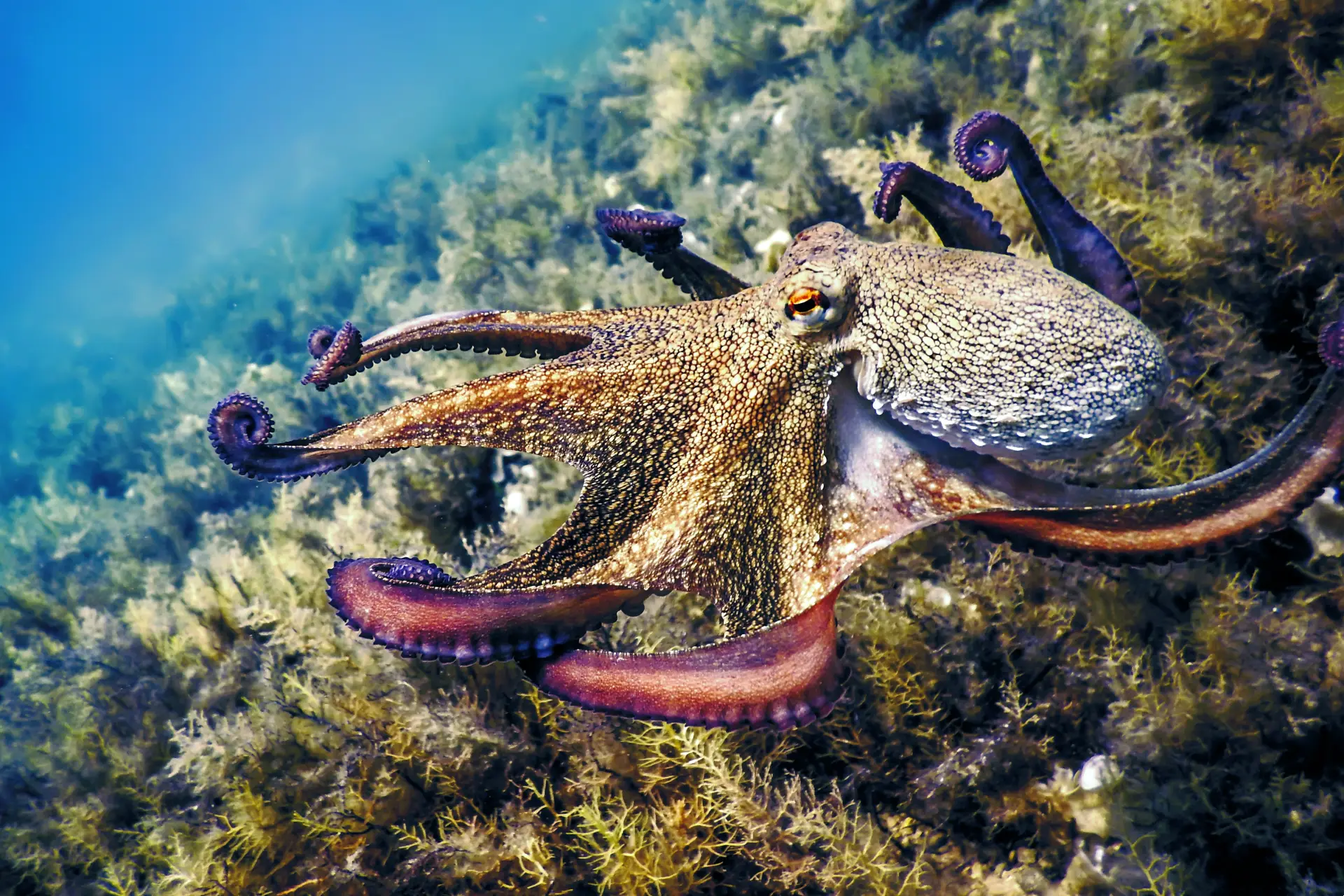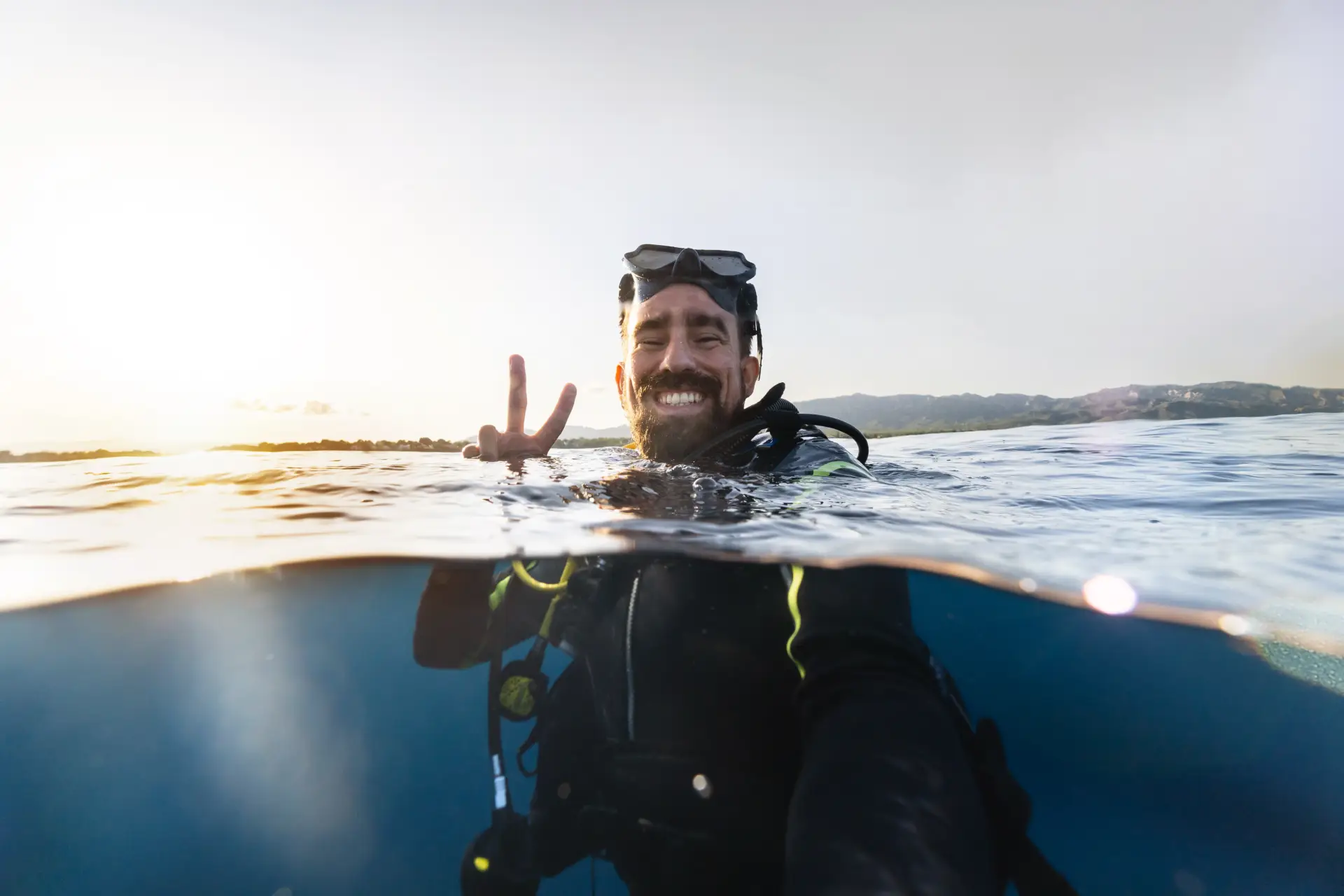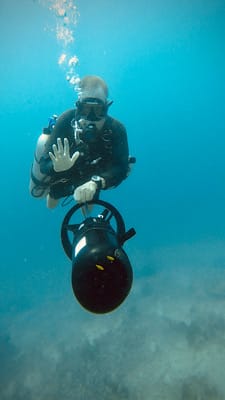Octopus Intelligence on Display: Meeting Bohol’s Clever Cephalopods
You’re drifting slowly over a patch of reef off Panglao Island, your eyes scanning the corals for a flash of colour. You notice a piece of rock covered in a bit of algae, unremarkable at first glance. You almost swim past, but something catches your eye. The rock seems to unfold. Two intelligent eyes materialize, observing you with an unnerving, ancient curiosity. In a fluid motion, the “rock” flows over the reef, changing its colour and texture in an instant to perfectly match a patch of sand, where it vanishes once more.
You’ve just had an encounter with one of the ocean’s undisputed geniuses: the octopus.
Here at Sierra Madre Divers, while we love the majestic turtles and grand schools of fish, there’s a special thrill that comes from finding one of these clever cephalopods. They are not just another creature on the reef; they are a glimpse into an alien intelligence, a life form so different from us it might as well be from another planet. With three hearts, copper-based blue blood, and a brain that extends through all eight of its arms, the octopus challenges our very definition of what it means to be smart.
Join us as we dive into the mind of the octopus and explore how you can witness their incredible intelligence right here in the waters of Bohol.
The Master of Disguise: More Than Just Colour Change

The octopus’s most famous trick is its ability to camouflage, but the reality is far more complex and astounding than simple colour-matching. Their skin is a high-tech biological screen, equipped with three layers of specialized cells.
- Chromatophores: These are tiny, pigment-filled sacs that the octopus can expand or contract in a fraction of a second using microscopic muscles. This is how they achieve their instantaneous, flashing colour changes.
- Iridophores: Beneath the chromatophores lies a layer of cells that act like living prisms, reflecting and scattering ambient light to create iridescent blues, greens, and golds.
- Papillae: Perhaps most incredibly, an octopus can control papillae in its skin to change its texture, going from perfectly smooth to bumpy and jagged in an instant to mimic the texture of a rock or a clump of coral.
This isn’t a simple reflex. An octopus will assess its surroundings and make a conscious decision about the best disguise. This is active, problem-solving intelligence on full display, and witnessing it firsthand is a core memory for any diver.
The Thinker in the Garden: Tool Use and Forethought
One of the definitive signs of higher intelligence in the animal kingdom is the use of tools. While primates are famous for it on land, the octopus is a card-carrying member of the tool-users club underwater. The premier example, which we are lucky to have in the Philippines, is the Coconut Octopus (Amphioctopus marginatus).
These crafty cephalopods are known for a remarkable behaviour: they actively seek out and collect empty coconut or clamshell halves from the seafloor. They will carry these cumbersome shells with them as they move across exposed, sandy plains. Why? For protection. When a predator approaches, the octopus will assemble the two halves around its body, creating a makeshift, portable fortress.
This isn’t just instinct. It demonstrates forethought, planning, and the ability to understand that an object can be used for a future purpose. It’s an astonishing piece of problem-solving that you can witness on the muck diving sites around Bohol.
The A-List Actors: The Mimic and the Wonderpus
Bohol is a world-class destination for spotting some of the most sought-after “celebrity” cephalopods. Chief among them is the legendary Mimic Octopus (Thaumoctopus mimicus).
The Mimic Octopus takes camouflage to a whole new level: impersonation. It doesn’t just blend into the background; it actively changes its shape and behaviour to imitate other, more dangerous sea creatures to deter predators. Divers have documented it pulling its arms in and flattening its body to look like a flounder, arranging its arms to mimic the venomous spines of a lionfish, or burying six of its arms in the sand and waving the other two to look like a banded sea snake. This requires not only incredible body control but also an awareness of which predator is threatening it and which disguise will be most effective.
Its cousin, the equally stunning Wonderpus (Wunderpus photogenicus), is another prized sighting. With a dramatic, fixed pattern of sharp white stripes and spots on a reddish-brown body, the Wonderpus uses its appearance to dazzle and perhaps warn predators. Watching one of these long-armed creatures probe for food in the sand is a true delight.
A Note of Respect: The Dazzling Blue-Ringed Octopus
No discussion of Bohol’s octopuses is complete without mentioning the tiny, beautiful, and highly venomous Blue-Ringed Octopus. Often no bigger than a golf ball, this reclusive creature is a holy grail for underwater photographers. When calm, its yellowish skin is covered in brown patches. But when it feels threatened, it flashes up to 60 iridescent, electric-blue rings—a clear and stunning warning.
That warning must be heeded. The Blue-Ringed Octopus carries a potent neurotoxin for which there is no antivenom. This is the ultimate “look, don’t touch” animal. A sighting is a rare privilege and a powerful reminder to always treat marine life with space and respect.
How to Find and Appreciate Bohol’s Octopuses
Spotting these masters of disguise requires a change in your diving style.
- Go Slow, Then Stop: You won’t find an octopus by swimming quickly. The key is to move slowly, then pause and carefully scan your surroundings. Look for shapes that seem just a little off.
- Look for Lairs: Search for “octopus gardens”—a den (often a hole or crevice) with a pile of discarded shells and crab carapaces outside. This is a sure sign someone is home.
- Try a Night Dive: Many octopus species are more active after sunset, venturing out from their dens to hunt. A night dive dramatically increases your chances of a great encounter.
- Trust Your Guide: The most effective way to find an octopus is to dive with one of our experienced Sierra Madre Divers guides. They have spent thousands of hours on these reefs and have a trained eye for spotting the subtle outline of a hidden octopus.
When you do find one, give it space. A calm, patient diver may be rewarded with one of the most incredible experiences in the ocean: a curious octopus reaching out a single, tentative arm to investigate the strange, bubble-blowing creature who has entered its world.
An encounter with an octopus is more than just a sighting; it’s a connection with another mind. It’s a privilege that reminds us that the ocean is filled with a depth of intelligence we are only just beginning to comprehend. Come dive with us, and let’s go search for the reef’s eight-armed geniuses.







